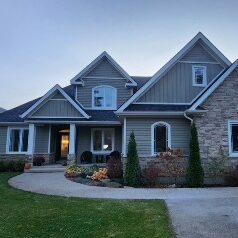Ontario’s 2025 Exterior Painting Costs: Secrets to a Dazzling Home
What’s the Real Cost of Ontario’s 2025 Exterior Painting? Unlock a Stunning Home How Much Does Exterior House Painting Cost in Ontario in 2025? Your Complete Guide to Prices and Tips Cost of Exterior House Painting in Ontario in 2025: What to Expect By Jordan Chemerys, Painting Contractor with 7+ Years of Experience A freshly painted exterior revitalizes your Ontario home, protects it from harsh Canadian weather, and enhances its curb appeal. But how much does it cost to paint a house in Ontario in 2025? At Heartmind Painting & Decorating, we estimate $4,000 to $13,000 for most projects, depending on home size, paint quality, and prep work. With labour rates of $50–$75 per hour, we deliver durable, high-quality results suited to Ontario’s climate. This guide breaks down costs, shares tips to save money, and helps you plan your painting project with confidence. Why Paint Your Home’s Exterior in Ontario? Exterior painting is a smart investment for Ontario homeowners. Here’s why: Let’s explore the costs to help you budget for your Ontario painting project. Key Factors Affecting Exterior Painting Costs in Ontario Drawing on 7+ years of painting homes across Ontario, we’ve pinpointed these cost drivers: Average Costs Across Ontario Home Types Here’s how costs look for typical Ontario homes: House Type Square Footage Cost Range Bungalow (Single-Story) 1,200–1,800 $4,000–$6,500 Two-Story Detached 2,000–3,000 $6,000–$9,500 Large Heritage Home 3,000–4,000+ $9,500–$13,000+ Notes: Based on $50–$75/hour labour, $30–$100/gallon paint, two coats, and standard prep. GTA costs may skew higher; northern Ontario may be lower. Sample Cost Breakdown: 2,000 sq ft Ontario Home For a 2,000 sq ft two-story home (common in suburbs like Oakville or Barrie): Note: Costs may rise in Toronto (e.g., $8,500–$9,000) due to higher labour rates or parking permits. How to Save on Exterior Painting in Ontario Here are practical ways to stretch your budget: Professional vs. DIY Painting in Ontario Should you hire us or paint yourself? Consider this: FAQs About Exterior Painting Costs in Ontario Q: How often should I repaint my Ontario home?A: Every 5–15 years. Basic paint ($30–$60/gallon) lasts 5–8 years; premium ($65–$100/gallon) lasts 12–15 years in Ontario’s climate. Q: Does painting boost home value in Ontario?A: Yes! A fresh exterior can add 2–5% to resale value—$12,000–$30,000 for a $600,000 home. Q: Why is prep so costly?A: Prep (20–30% of labour) ensures durability. For example, 20 hours of scraping at $50–$75/hour costs $1,000–$1,500 but prevents peeling in Ontario’s winters. Q: Is premium paint worth it in Ontario?A: For long-term owners, yes. $65–$100/gallon paints resist snow, humidity, and UV better, saving $4,000–$10,000 over time. Q: Can I paint during Ontario winters?A: Rarely—temperatures below 5°C slow drying. Aim for April–October for best results. Ontario-Specific Tips for 2025 Ready to Paint Your Ontario Home? Exterior painting costs in Ontario in 2025 range from $4,000 to $13,000, based on your home’s size, paint choice, and prep needs. At Heartmind Painting, we charge $50–$75 per hour and use $30–$100 per gallon paints to ensure quality in Ontario’s tough climate. For a free quote, measure your home’s square footage or contact us today. Need colour ideas? Visit our 2025 Ontario Paint Trends Guide (Sherwin Color Palette) (Benjamin Moore Color Palette) Have questions? Comment below or call us for expert advice tailored to Ontario!


